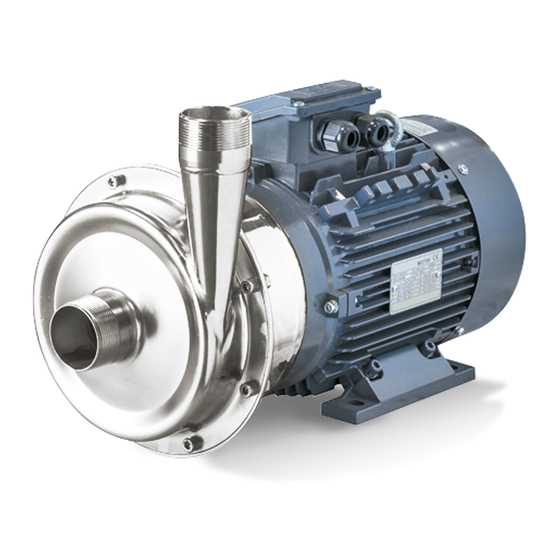
Table of Contents

Summarization of Contents
1. Introduction
Check Shipment
Check pump and other received articles against the shipping voucher for conformity.
Manual Information
Information in this manual refers to updated data; INOXPA reserves the right to modify specifications.
Operating Principles & Safety
Introduces safety symbols and provides detailed safety precautions for operation, maintenance, and assembly.
Warranty and Service
Warranty Terms
Details conditions under which the warranty is null and void, including improper maintenance or unauthorized modifications.
INOXPA Service Contact
Contact INOXPA for assistance with doubts, explanations, or specific procedures.
3. General Information
Description
Details the construction and intended use of ESTAMPINOX ES, ER, EFH, EFN centrifugal pumps.
Materials and Sealing
Details construction materials and options for mechanical seals, including materials for rotating and stationary parts.
Field of Application
Presents performance curves (head vs. flow rate) for different pump models at specific speeds.
4. Installation
Installation Basics
Basic instructions for pump installation, emphasizing the importance of reading the manual before assembly.
Location, Piping, Stability
Guidance on optimal pump placement, piping, accessibility, managing high temperatures, and foundation requirements.
Handling and Electric Motors
User responsibility for assembly and electrical connection, safety, and motor selection.
Direction of Rotation
Explains how to identify and ensure correct clockwise rotation of the pump for optimal performance.
Suction and Discharge Pipes
Recommendations for pipe sizing, layout, and avoiding head losses for efficient pump operation.
5. Start-up
Start-up Considerations
Ensures pump start-up follows installation instructions and personnel are informed of operation and safety.
Pre-Start Cleaning
Pre-start check to ensure pipes and pump are clean and free of foreign particles.
Start-up Procedure
Step-by-step guide for safely starting the pump, checking suction pressure, and discharge pressure.
6. Maintenance
Maintenance Basics
Emphasizes following instructions for maintenance to prevent faulty operation and damage.
Conservation and Cleaning
Procedure for preserving the pump during inactivity and advice on keeping the pump exterior clean.
Electrical Maintenance
States that electrical maintenance must be done by qualified personnel with power cut off.
General Maintenance Checks
Periodic checks of pressures, motor inspection, and mechanical seal care.
7. Operating Problems
Problem Identification
Lists common pump operating problems and their probable causes.
Problem Solutions
Provides solutions for various identified pump operating issues, referencing relevant sections.
8. Disassembly and Assembly
General Procedures & Safety
Emphasizes qualified personnel, safety precautions, and safe disconnection procedures for assembly/disassembly.
Pump Housing and Impeller Steps
Instructions for disassembling and assembling the pump housing, and removing the impeller and pump cover.
Mechanical Seal and Impeller
Details disassembly/assembly of mechanical seals and mounting of the impeller onto the shaft.
Motor Replacement
Instructions for replacing the motor, referencing disassembly sections for specific pump types.
EFH/EFN Type Motor Steps
Specific steps for disassembling the motor or ball bearings for EFH/EFN pump types.
9. Technical Specifications
Specification Tables
Table detailing motor power, sealing shaft, impeller diameter, and weight for various pump types.
Materials List
Lists parts in contact with the liquid and their corresponding materials and material numbers.
10. Cleaning and Disinfection
Cleaning Considerations
Highlights the necessity of cleaning and disinfection in the food industry and user responsibility for programs.
Cleaning Methods
Describes two methods for pump cleaning: CIP (Cleaning in Place) and disassembly.
Cleaning Safety
Provides safety guidelines for manual cleaning and CIP procedures, including disconnecting power and protective equipment.
















Need help?
Do you have a question about the ESTAMPINOX EFI-2003 and is the answer not in the manual?
Questions and answers